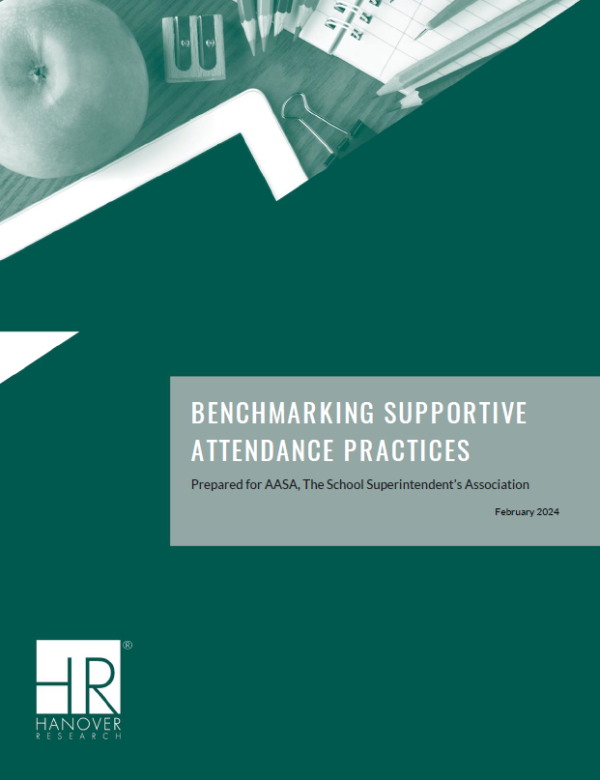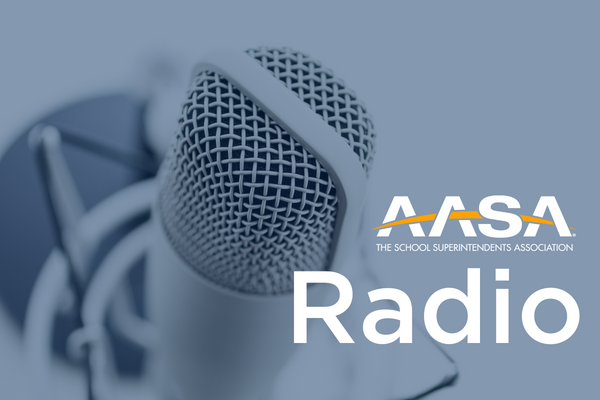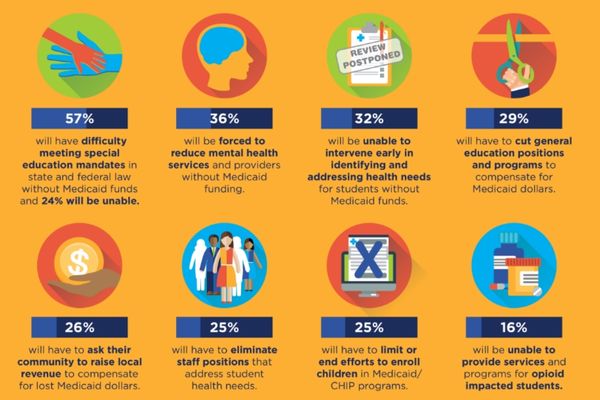Benchmarking Supportive Attendance Practices
February 08, 2024
State profiles aimed at improving attendance by addressing mental health and social-emotional learning (SEL) supports, improving learning environments, and engaging community partners

States and districts across the United States face challenges maintaining strong attendance in the wake of the COVID-19 pandemic. Also, states and districts have moved away from traditional law enforcement-focused approaches to truancy due to research suggesting that punitive approaches may be less effective in encouraging school attendance and lead to long-term negative consequences for students and families. In this report, Hanover Research (Hanover) reviews recent state practices focused on addressing attendance challenges. The report consists of state profiles aimed at improving attendance by addressing mental health and social-emotional learning (SEL) supports, improving learning environments, and engaging community partners. Within, Hanover also provides links to resources developed by state education agencies and partner organizations.
Recommendations
Based on the findings, Hanover suggests district leaders consider the following recommendations:
- Use data to identify the root causes, especially causes linked to students’ and families’ mental health and SEL needs, in addressing attendance challenges and plan appropriate responses. Across states, guidance on addressing attendance challenges emphasizes there is no single strategy that will be effective in all cases, because attendance challenges may reflect a variety of root causes associated with the student, family, school, or community. Effective attendance teams analyze attendance data to identify root causes and plan interventions to address these causes. For example, New Jersey developed a data-based decision-making process attendance teams can use to review attendance data and plan interventions for individual students, classrooms, and the school.
- Integrate attendance supports into a multi-tiered system of supports (MTSS) that addresses barriers to attendance such as mental health challenges, school climate issues, and lack of awareness of the importance of attendance. For example, New Jersey, New Mexico, and Virginia recommend districts adopt an MTSS structure for attendance or integrate attendance supports into a comprehensive MTSS. MTSS ensures that all students receive the level of support they need, with universal supports creating a positive school climate and ensuring awareness of the importance of attendance and targeted or intensive support, including mental health resources, for students who face barriers to attendance.
- Conduct outreach to families to build positive relationships and identify students’ mental health and SEL needs. Several states identify family outreach as an essential strategy to ensure families have the resources they need to support attendance and to engage families as partners in supporting attendance. Connecticut’s Learner Engagement and Attendance Program (LEAP), which relies on home visits to build positive school-family relationships, has demonstrated a significant positive effect on attendance for participating students.
- Engage constituents across the district and community in identifying challenges and solutions for attendance. States profiled in this report leverage expertise and resources of community partners to support attendance improvement efforts. For example, the Illinois Department of Human Services and Chicago Public Schools collaborate with three organizations that work with young people in Chicago to support the Back to Our Future program, while the Ohio Department of Education works with higher education partners, sports teams, the juvenile justice system, and other community partners to support an awareness campaign and identify best practices for improving attendance.
- Several states specifically incorporate mental health into their recommended strategies to improve attendance. For example, Wisconsin has developed an FAQ sheet with recommendations for supporting students with mental health challenges to attend school regularly. Other states, such as Ohio, New Mexico and Connecticut, integrate mental health supports and SEL into MTSS frameworks for attendance.
- Interventions to address attendance challenges often focus on building positive relationships between students and adults in schools. For example, several school districts in South Dakota hired attendance liaisons who work with students and their families to overcome barriers to attendance. Similarly, Virginia recommends schools consider Relationship Mapping, a strategy in which schools identify students who do not currently have a positive connection with an adult in the school, and assigns these students an adult mentor as a strategy to improve attendance outcomes.
- State education agencies collaborate with other state agencies interested in promoting positive outcomes for youth to provide guidance on best practices for improving attendance and support for attendance initiatives. For example, the Ohio Department of Education collaborates with the Ohio Supreme Court and local juvenile courts to develop a guide to addressing truancy, with the goal of reducing truancy referrals to the juvenile justice system. Similarly, the Office of the Attorney General of California developed a guide to reducing truancy in collaboration with several government agencies, community groups, and professional organizations across the state, including the California Department of Education.
- In some cases, recent attendance initiatives build on or update initiatives in place before the COVID-19 pandemic. For example, New Jersey recently updated guidance published before the pandemic to emphasize using student data to identify effective attendance interventions. Ohio expanded on a statewide attendance awareness campaign launched in 2019 by convening a statewide attendance task force and publishing a guide to improving district level attendance in 2023. Similarly, Connecticut published guidance to addressing chronic absenteeism for school districts in 2017 and launched an attendance initiative focused on home visits for chronically absent students, the Learner Engagement and Attendance Program (LEAP) to support attendance as students returned to in-person learning following the COVID-19 pandemic.
- Several states require schools and districts to establish formal attendance improvement plans and establish teams to review and act on attendance data on a case-by-case basis that ultimately will require addressing students’ mental health and SEL. For example, New Mexico requires all districts to establish Attendance Improvement Plans that will include mental health and SEL supports when needed for those students. New Jersey requires schools with high chronic absenteeism rates to develop corrective action plans by establishing problem-solving teams made up of diverse constituents to implement data-based decision-making processes. Because solutions for students are identified based on the root causes for their absenteeism, mental health and SEL supports are applied as needed.

About Hanover Research
Founded in 2003, Hanover Research provides high-quality K-12 research & analytics through a cost-effective subscription model that helps executives make informed decisions, identify, and seize opportunities, and heighten their effectiveness. We do this by providing actionable data, insights, and guidance to educate the whole child with solutions in curriculum & instruction, diversity, equity & inclusion, academic program planning & impact, district strategic planning, teacher recruitment & retention, operational planning and culture, climate & family engagement.
Advertisement
Advertisement
Advertisement
Advertisement



-(16).png?sfvrsn=44688378_7)